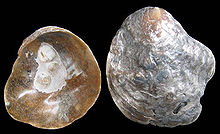Anomia (bivalve)
| Anomia | |
|---|---|

| |
| Two upper valves of A. ephippium | |
| Scientific classification | |
| Kingdom: | Animalia |
| Phylum: | Mollusca |
| Class: | Bivalvia |
| Order: | Pectinida |
| Family: | Anomiidae |
| Genus: | Anomia Linnaeus, 1758 |
| Species | |
| |
| Synonyms | |
| |
Anomia is a genus of saltwater clams, marine bivalve mollusks in the family Anomiidae. They are commonly known as jingle shells because when a handful of them are shaken they make a jingling sound,[2] though some are also known as saddle oysters.[3]
This genus first appeared in the Permian period of China, Italy, and Pakistan.[4] Anomia species are common in both tropical and temperate oceans and live primarily attached to rock or other shells via a calcified byssus that extends through the lower valve.[1] Anomia shells tend to take on the surface shape of what they are attached to; thus if an Anomia is attached to a scallop shell, the shell of the Anomia will also show ribbing.[1] The species A. colombiana has been found in the La Frontera Formation of Boyacá, Cundinamarca and Huila of Colombia.[5]
Species[]
Species:[6]
- Gray, 1850
- Giebel, 1856
- Brocchi, 1814
- Giebel, 1856
- Linnæus, 1758
- Gray, 1849
- Morton, 1833
- Linnæus, 1758
- Giebel, 1856
- Linnæus, 1758
- Hisinger, 1799
- Brocchi, 1814
- Brocchi, 1814
- Martin, 1909
- Linnaeus, 1758
- Philippi, 1849
- Brocchi, 1814
- Sowerby, 1836
- Brocchi, 1814
- (Roemer, 1839)
- Linnæus, 1758
- Tate, 1886
- Gray, 1850
- Iqbal, 1980
- Gabb, 1860
- Anomia ephippium Linnaeus, 1758
- Linnæus, 1758
- Stoppani, 1865
- Linnaeus, 1758
- Harris, 1919
- Wiedey, 1929
- Houttuyn, 1787
- Cossmann, 1887
- Linnaeus, 1758
- Clark, 1918
- Eames, 1951
- Hislop, 1860
- Linnaeus, 1758
- Sowerby, 1836
- Gabb, 1864
- Whiteaves, 1900
- Aldrich, 1886
- M.Huber, 2010
- Anderson, 1929
- Hanna, 1927
- Dockery, 1982
- Stoppani, 1865
- Harris, 1919
- Richards, 1943
- Brocchi, 1814
- Gabb, 1876
- Locard, 1898
- Eames, 1951
- Orbigny, 1847
- Brown, 1905
- Linnæus, 1758
- Brocchi, 1814
- Wade, 1926
- d'Orbigny, 1846 (synonym: Gray, 1850)
- Brocchi, 1814
- Deshayes, 1858
- Gemmellaro, 1896
- d'Orbigny, 1850
- Sowerby, 1836
- Linnaeus, 1758
- Conrad, 1843
- Linnaeus, 1771
- (Winkler, 1859)
- Stanton, 1895
- Olsson, 1928
- Maury, 1936
- Anomia simplex d'Orbigny, 1853
- Brown, 1905
- Brocchi, 1814
- Linnæus, 1758
- Brocchi, 1814
- J.de C.Sowerby, 1823
- Linnaeus, 1758
- Orbigny, 1850
- Martin, 1922
- Mansfield, 1940
- Deshayes, 1824
- Linnaeus, 1758
- Anomia trigonopsis F.W.Hutton, 1877
- Gabb, 1869
- Loel & Corey, 1932
- Martin, 1881
- Brocchi, 1814
Reassigned species[]
As Anomia was erected very early in paleontology, several species have been reassigned; most of them are now recognized as brachiopods.[7][8]
- A. angulata = , brachiopod
- A. biloba = Dicoelosia biloba, brachiopod
- A. bilocularis = , brachiopod
- A. caputserpentis Linné, 1758 = undetermined terebratulid brachiopod
- A. caputserpentis Linné, 1767 = Terebratulina caputserpentis, brachiopod
- A. craniolaris = Crania craniolaris, brachiopod
- A. crispa = , brachiopod
- A. detruncata = , brachiopod
- A. furcata = Monia zelandica
- A. nobilis =
- A. pectinata = , brachiopod
- A. placenta = Placuna placenta
- A. psittacea = Hemithiris psittacea, brachiopod
- A. reticularis = Atrypa reticularis, brachiopod
- A. retusa Linné, 1758 = Terebratulina caputserpentis, brachiopod
- A. rubra = , brachiopod
- A. sella = Placuna quadrangula
- A. squamula =
- A. terebratula = Terebratula terebratula, brachiopod
- A. vitrea = Gryphus vitreus, brachiopod
References[]
- ^ a b c Ludvigsen, Rolf & Beard, Graham. 1997. West Coast Fossils: A Guide to the Ancient Life of Vancouver Island. pg. 109
- ^ Gofas, S. (2010) Anomia Linnaeus, 1758. In: Bouchet, P.; Gofas, S.; Rosenberg, G. (2010) World Marine Mollusca database. Accessed through: World Register of Marine Species at http://www.marinespecies.eu/aphia.php?p=taxdetails&id=137650 Archived 2016-03-04 at the Wayback Machine on 2010-06-06
- ^ "Saddle oyster - Anomia ephippium". The Marine Life Information Network.
- ^ Paleobiology database entry on Anomia
- ^ Patarroyo, Pedro (2016). "Amonoideos y otros macrofósiles del lectoestratotipo de la Formación la Frontera, Turoniano inferior - medio (Cretácico Superior) en San Francisco, Cundinamarca (Colombia)" (PDF). Boletín de Geología, Universidad Industrial de Santander. 38: 41. Retrieved 2017-04-04.
- ^ "Anomia Linnaeus, 1758". www.gbif.org. Retrieved 10 October 2021.
- ^ Moore, R.C., ed. (1965). Brachiopoda. Treatise on Invertebrate Paleontology. Part H., Volume 1 and 2. Boulder, Colorado/Lawrence, Kansas: Geological Society of America/University of Kansas Press. ISBN 0-8137-3015-5.
- ^ Moore, R.C.Paleontological Institute (ed.). Part N, Mollusca 6, vol. 1 & 2. Treatise on Invertebrate Paleontology. Archived from the original on 9 October 2016. Retrieved 5 December 2013.
- Anomiidae
- Bivalve genera
- Fossil taxa described in 1758
- Taxa named by Carl Linnaeus
- Bivalve stubs